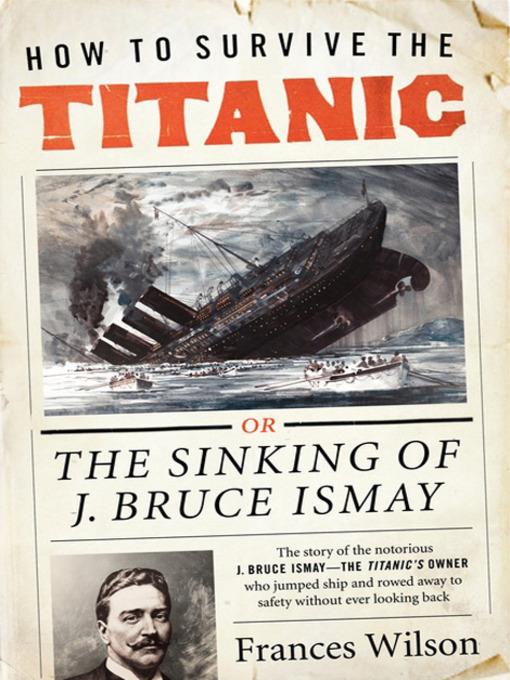
How to Survive the Titanic
فرمت کتاب
ebook
تاریخ انتشار
2011
نویسنده
Jennifer Loisنویسنده
Jennifer Loisنویسنده
Frances Wilsonناشر
Harperشابک
9780062094568
کتاب های مرتبط
- اطلاعات
- نقد و بررسی
- دیدگاه کاربران
نقد و بررسی

July 25, 2011
This searching if sometimes clouded historical-literary study explores the meanings of the famous shipwreck through the enigmaticâor perhaps stuntedâinner life of a notorious cad. Ismay, a Titanic passenger and managing director of the firm that owned the ship, was condemned for violating the gentleman's code by, instead of going down with the ship, taking a lifeboat berth that might have gone to a woman or child; he was also blamed for the shortage of lifeboats and the ship's reckless speed in the ice field. Wilson (Literary Seductions) gives an absorbing account of the disaster and its cultural associations, but poring over Ismay's evasive public statements and newly unearthed, self-pitying letters glean her few insights into his culpability and characterâfor that she resorts to exegeses of Lord Jim and other Joseph Conrad tales about disgraced seamen. In treating the stolid, unapologetic Ismay as a tortured Conrad characterâ"Was Ismay a super captain, a double captain or a double agent, living both the life of the ship and the life of the passenger?ââWilson sometimes mistakes lit-crit conceits for analysis. Still, her approach yields a rich meditation on the mere moment's hesitation that separates cowardice from courage. Photos.

August 1, 2011
Bruce Ismay, the managing director of the White Star shipping line, became infamous because of the night in April 1912 that he boarded a lifeboat leaving his company's brand new ship, Titanic, to sink and more than 1500 passengers and crew to die. Not technically a passenger, he as the ship's "owner" bore some responsibility for the lack of adequate lifeboats; his right to a seat in one of those lifeboats has been debated for almost 100 years. Wilson (The Ballad of Dorothy Wordsworth), with access to Ismay family material in private hands and an impressive command of the sources, has composed a very readable study of an unsympathetic character. Notions of duty and responsibility, of heroism and cowardice, are thoughtfully discussed. Wilson draws comparisons between Ismay and Joseph Conrad's title character in Lord Jim, but some readers might wish to skip the tangential discussions of Conrad's life and works. VERDICT It is a pleasure to read a book, as the centennial of the Titanic sinking approaches, that offers something new on this topic. Titanic completists will certainly want this, and it is also recommended for readers of biography and Edwardian-era history.--Megan Hahn Fraser, Univ. of California-Los Angeles Lib.
Copyright 2011 Library Journal, LLC Used with permission.

August 15, 2011
Wilson (The Ballad of Dorothy Wordsworth, 2009) tells the story of the Titanic's polarizing owner, who was aboard the vessel and survived its fatal 1912 collision with an iceberg.
The author demonstrates an impressive knowledge of that night to remember. She reminds us of the ship's enormous size, its "unsinkable" reputation, its insufficiencies (not nearly enough lifeboats) and its principal function: to transport emigrants, who composed the large majority of the passengers. But her focus is the ship's laconic owner, J. Bruce Ismay, who found a spot on one of the last lifeboats to leave the stricken vessel. (He later claimed, with some eyewitnesses' substantiation, that no one else was around; a seat was open so he took it.) Many later reviled him, believing he should have chosen to perish with those left behind. Throughout, Wilson relies heavily not just on the documentary evidence--there were official hearings on both sides of the Atlantic; she summarizes both in detail--but on her literary training and interest. Allusions to literature abound--Moby-Dick, "The Rime of the Ancient Mariner," Frankenstein, Charles Dickens, Alice in Wonderland, Virginia Woolf (who attended some of the hearings in England), E.M. Forester and, most significantly, Joseph Conrad and his Lord Jim, a novel whose plot parallels in striking fashion the story of Ismay. At times, Wilson loses herself in Conrad, and one chunky section of her text resembles nothing so much as an essay by an earnest grad student of Modern British Literature. Literary analogies can be arresting, but the author's tour of Conrad is excessive and distracting. Far better are the sections where she mines Ismay's pathetic letters, the numerous newspaper accounts and the survivors' testimony.
An up-and-down history of an intriguing figure.
(COPYRIGHT (2011) KIRKUS REVIEWS/NIELSEN BUSINESS MEDIA, INC. ALL RIGHTS RESERVED.)

























دیدگاه کاربران